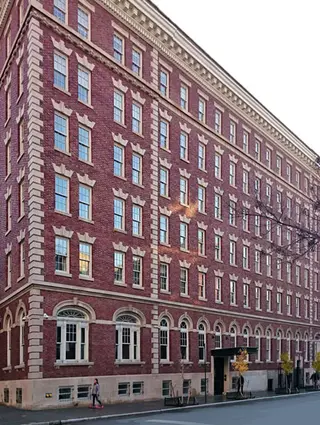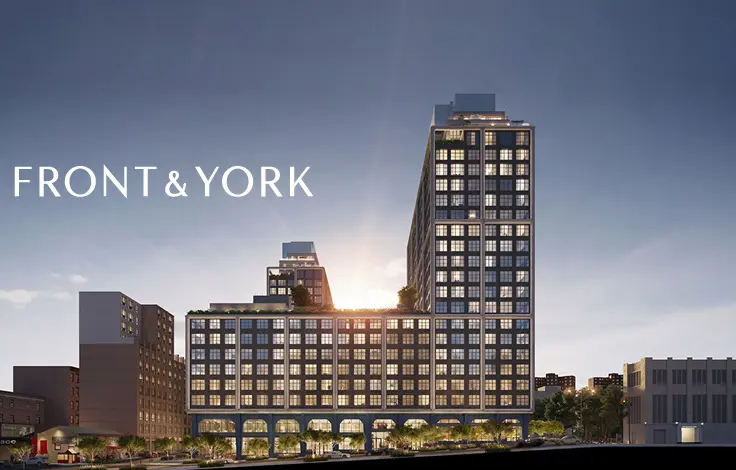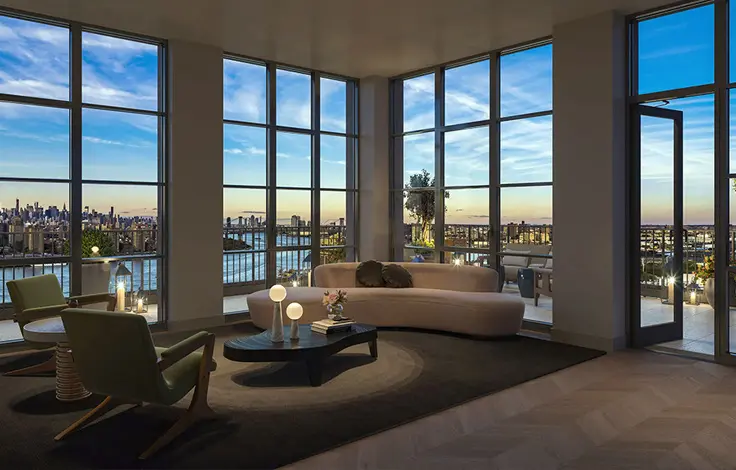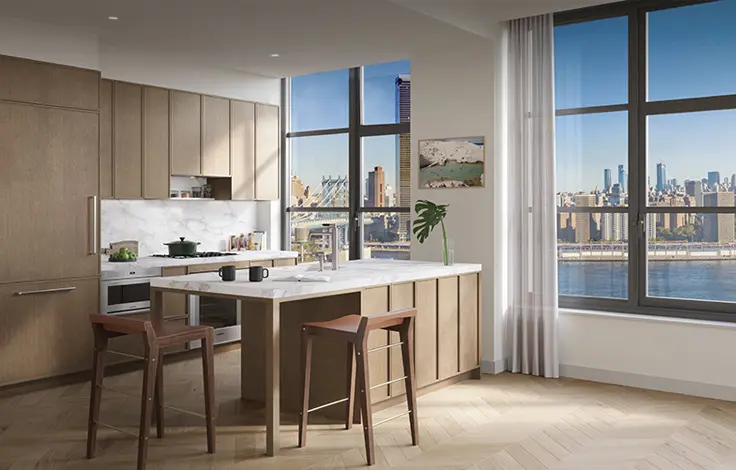 Carter Horsley
Carter HorsleyJul 10, 2015
Carter's Review
This very handsome, 7-story, large, red-brick building at 320 West 12th Street on the southwest corner at Hudson Street in the West Village was erected in 1906 as housing for young working women and then was converted in 1958 to The Village Nursing Home before becoming in 2013 ten luxury condominium apartments.
FLANK, which is headed by Jon Kully and Mick Walsdorf, was the developer and architect. It also designed and built the copper-clad apartment building at 385 West 12th Street and the thin metal-clad building at 441 West 57th Street.
The building is also known as 607 Hudson Street.
Bottom Line
Very large apartments in a very elegant Georgian-style building overlooking Abingdon Park in the West Village.
Description
The building has an impressive colonnaded entrance with balustrade balcony on Hudson Street and another in the middle of its long 12th Street façade.
The building has quoins, splayed and paneled lintels, and handsome arched windows on its first floor.
There are stringcourses above the first and 5th floors and the cornice is large with dentils.
Amenities
The building has a doorman, a fitness center, a porter, storage and valet service.
Apartments
An article by Stephen Jacob Smith in the July 3, 2013 edition of the Commercial Observer noted that Steven Cohen, the operator of a hedge fund and an art collector, bought for $23.4 million the maisonette triplex apartment in the building with 9,600 square feet. Mr. Cohen at the time also had a $38.8 million apartment at 145 Perry Street and penthouse at One Beacon Court he was trying to sell for $115 million.
History
According to a marvelous article at the extremely excellent daytonianinmanhattan.com, the building was erected by William R. H. Martin, the son of John T. Martin, who supplied uniforms to the Army in the Civil War and later joined with Marvin Rogers to form Rogers, Peet & Co., a prominent clothing concern in the city. In 1900, William Martin opened the Martinique Hotel near Times Square and a few years later brought the land at this site and commissioned Ralph S. Townsend to design a “Colonial” building as a hotel for working girls. He named the hotel the Trowmart Inn after his dead son, Trowbridge Marin. Initially, it could accommodate about 400 girls in 10-by-12-foot rooms with a window, a closet, a bed, a dressing table, a washstand and a couple of chairs.
The article noted that “The Times was impressed with the ‘mammoth’ dining room with its 16 windows with muslin curtains…[and] ecru coloring…Ralph Townsend was especially proud of the kitchens, bakery and refrigerators in the basement, telling the newspapers that ‘neither the St. Regis nor the Waldorf-Astoria is superior in its culinary appointments.’ Girls were allowed to do their laundry, for free, in the porcelain tubs and use the building’s gas for ironing.” The Times article also noted that “each floor is equipped with a small ironing room which has tables, boards, irons and holders all ready for the smoothing out of the dainty small accessories so dear to the feminine heart.”
Mr. Marin also had his architect design six parlors “where the girls could entertain young men with decorum” and the newspaper article said that “girls of gentleness and refinement do not care to be courted upon the open highway, nor in public parks, and thus the world is filling with spinsters, who, according to Mr. Martin, had they a proper place I which to entertain their admirers would develop into happy, excellent wives and still happier mothers.”
The Trowmart Inn also had a library, a medical office and numerous bathrooms.
For $3 a week for a shared room and $4 for a single room, girls who earned less than $12 a week and were under 35 years old could get breakfast and super and for 15 cents extra lunch on holidays and Sundays.
The New York Sun reported that “no man, not even a grand-father, may be entertained by a guest in her room or taken on any pretext above the ground floor. The World’s Work reported that “the elevators stop running at 11 o’clock” and “the girls who come after that time must walk up the stairs” and that “three times a week dances were held in the parlor.”
In 1918, it was announced that the hotel would provide accommodations for the nurses and men attendants that were working at the Siegel-Cooper Department Store building on Sixth Avenue that had been converted to a hospital. At the end of World War I, the 400-room hotel sat empty until John D. Rockefeller Jr. donated $300,000 to buy the hotel and convert it to the Laura Spelman Hall, a women’s residence hall operated by the Young Women’s Christian Association and it was named after his dead wife, Laura Celestia Spelman. Its renovation by Katherine C. Budd resulted in its room count being lowered to 258.
Eventually it was turned into the Village Nursing Home and in 1977 its 184 residents came under the care of the Caring Community.
In 2007, the nursing home sold the building to FLAnk for $33 million and three years later it moved to a new 105-bed location at 214 West Houston Street.
Abingdon Square Park, a small, triangular park in the West Village formed by the intersection of Eighth Avenue and Hudson, Bank and West 12th streets, is one of the more elegant in the city.
It is bounded on the north by two handsome 17-story, pre-war apartment buildings and this cheery, red-brick building that was originally the Trowmart Inn when it was built by William Martin as a residence hotel for young ladies in 1906.
The two taller apartment buildings were part of a group of five, prominent and elegant apartment buildings developed by Bing & Bing in Greenwich Village in the early 1930s.
An article by Josh Barbanel in The Wall Street Journal noted that FLAnk started marketing the building’s two penthouses, for $19.5 and $21 million, respectively, even though the rest of the building’s apartments will not hit the market until later.
The quarter-acre park was enclosed with a cast-iron fence in 1836 and Calvert Vaux, a co-designer with Frederick Olmstead of Central Park, created a new design for the small park in the 1880s.
Since 1994, there has been a greenmarket on the sidewalks around the Abington Square Park on Saturdays.
The park is name for Charlotte Warren, a resident of the area in the 18th Century who married Willoughby Bertie, the 4th Earl of Abingdon. Her father, Sir Peter Warren, a British naval officer, had bought in 1740 about 300 acres of land between the Hudson River and the Bowery and from Charles to West 21st streets and he gave a wedding gift to his daughter of the land that became known as Abingdon Square.
In 1921, Governor Alfred E. Smith presided at the unveiling in the park of a statue of a World War I soldier, known as a “doughboy,” carrying a flag.
A row of red-brick townhouses was demolished on the north side of the park in 1931 for the 17-story apartment building at <a href=https://www.cityrealty.com/nyc/west-village/299-west-12th-street/8255”>299 West 12th Street</a> developed by Bing & Bing and designed by Emery Roth. The 182 apartments in the building have wood-burning fireplaces and step-down living rooms and were converted to condominiums in 1986.
The developer at about the same time commissioned Boak & Paris, an architectural firm made up Russell M. Boak and Hyman F. Paris, former employees of Emery Roth, to design a very similar, 17-story, 129-unit apartment building at <a href=https://www.cityrealty.com/nyc/west-village/302-west-12th-street/1323”>302 West 12th Street</a>, also fronting on the park. It was also converted to condominiums in 1986.
Boak & Paris also designed the similar apartment building at <a href=https://www.cityrealty.com/nyc/greenwich-village/45-christopher-street/534>45 Christopher Street</a> for Bing & Bing, which also used Mr. Both for the similar apartment building at <a href=https://www.cityrealty.com/nyc/greenwich-village/59-west-12th-street/7571>59 West 12th Street</a> and Robert T. Lyons for the similar apartment building at <a href=https://www.cityrealty.com/nyc/west-village/2-horatio-street/969”>2 Horatio Street</a>.
In 1929, Leo Bing, who with his brother, Alexander, ran Bing & Bing, was reported as stating that his goal was to “recreate the entire district as a modern counterpart of the high-class residential section it once was,” adding that it would “rival Central Park and the fashionable east side within a few years.”

- Condo built in 1906
- Converted in 2013
- Located in West Village
- 10 total apartments 10 total apartments
- 10 recent sales ($8.9M to $33.5M)
- Doorman






 6sqft delivers the latest on real estate, architecture, and design, straight from New York City.
6sqft delivers the latest on real estate, architecture, and design, straight from New York City.
